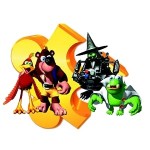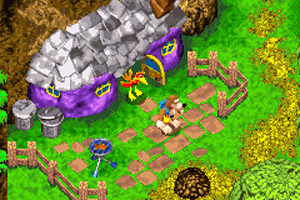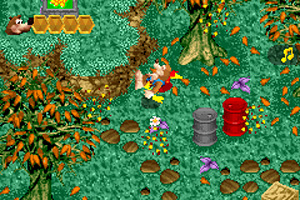
Banjo-Kazooie: Grunty’s Revenge review
It was only after 2002 that things began to look grim for Banjo-Kazooie fans around the world. Microsoft had bought out Rare completely – both Rare’s 51% and Nintendo’s 49% share. Banjo-Threeie would not be coming to the Nintendo 64; nor to the Gamecube, for that matter. Fans began to worry about whether or not a true sequel would actually surface, whether it be on a Nintendo console or Microsoft’s.
As it turned out, Rare did have plans to keep the Banjo franchise alive. However, they hadn’t decided to bring out a true sequel just yet. Instead, Rare teamed with THQ and made a deal which allowed them to produce titles for Nintendo’s handhelds, since Microsoft hadn’t produced a handheld console of their own. Banjo-Kazooie: Grunty’s Revenge was born; a new title which took place in between the events of the two N64 titles, using the same platforming gameplay that the first two rocked the gaming world with several years ago. However, in creating another game on the same projected timeline as the two N64 originals, Rare had set the new title up for comparison with Banjo-Kazooie and Tooie. Being able to produce a game experience on par with these two classics was an unachievable feat for a GBA title because of the obvious hardware limitations, and thus the game was doomed to disappoint fans before it had even made itself into their palms.
Of course, the new game could be easily cast aside because of its inability to produce the magic of its console predecessors. However, these issues aside, was the game a good GBA title in itself? If one did not have the first two titles to compare this game with, would they consider it a good game?
Those who control the past, control the present…
Creating a game which takes place between two other great titles – games where the sequel seems to pick up directly where the original left off – is no easy feat. Thus the storyline for Grunty’s Revenge has taken the only other route possible. Two months after her defeat in Banjo-Kazooie, Klungo builds a fine, mechanical suit for Gruntilda’s soul to inhabit. Grunty then plots her revenge; by kidnapping Kazooie and travelling into the past so that the bear and bird can never meet each other in the first place, preventing them from thwarting her original plans to steal Tooty’s good looks. Banjo must travel to the past with the help of Mumbo’s magic if he wishes to have any chance of saving his friend from the evil clutches of Gruntilda.
After sitting down and having a bit of a think about all of this, it becomes apparent that the story doesn’t quite make sense. If Gruntilda wanted to prevent the bear and bird from meeting, she’d have to travel to the past and prevent the old Kazooie from meeting Banjo – kidnapping Kazooie and taking her to the past is going to have all sorts of weird side effects, but won’t make a difference if Grunty wants to prevent her from meeting Banjo in the first place. Then there’s the question of characters like Honey B – if she appears to be roughly twenty years old or so in the past, then how is she the same age so many years in the future in Banjo-Tooie? Another thing – where are Banjo, Kazooie and Gruntilda in the past? Sure, they’ve all travelled to the past, but there’s no sign of their past selves at all!
The previous Banjo games may not have had epic storylines so to speak, but I think it’s easy to say they made more sense than this one. Of course, it’s pretty difficult to create a time travel based story without facing a couple of plot holes, so when playing the game you have to try and ignore that for a little while as you go. And while the nonsensical elements mentioned above may make this a little hard, it isn’t hard for one to lose track of the half-baked plot since there’s no mention of time travel between the beginning of the game and the moment where you finally defeat Gruntilda.
On with the jiggy hunt, then…
Banjo-Kazooie: Grunty’s Revenge offers a brand new quest for fans of the original games, with sixty jiggies to collect over the course of six worlds, including a brand new and revamped hub world, Spiral Mountain. All of the collectables of the original return again; extra honeycombs to trade into Honey B. for life bar extensions, Jinjos and notes to trade in for moves, much like in Banjo-Tooie. The note system used takes the best of both Banjo-Kazooie and Tooie and merges them into one – notes collected are singular, so it’s not too easy a task to find them all in a level like it was in Tooie, however, like in BT, they’ve become a once-only item like jiggies and honeycombs, so once you pick them up, there’s no need to come back again if you die; one of the only factors which annoyed fans of the original game.
Speaking of notes and moves, Grunty’s Revenge introduces Bozzeye, grandfather of Bottles and Jamjars from the previous games. Bozzeye will be able to teach you several moves from both Banjo-Kazooie and Tooie, including the wonderwing and bill drill. Unfortunately, due to the GBA title’s design, you won’t be able to fly around the levels, and you’ll only be able to use the wonderwing upon finding a special pad with a gold feather upon it. But apart from these two problems, you’ll find that the majority of Banjo and Kazooie’s moves have made a nice transition from the N64 onto the Gameboy, as you’ll still be able to flap around with Kazooie, talon trot up slopes and rat-a-tat rap at the bad guys with ease.
The real problem in the transition from console to handheld has come in the way the game has been designed. Obviously the controllable camera from the first games was not going to translate easily onto the gameboy advance, and thus the Banjo team has opted for a simpler way out; namely, by using a fixed camera in an oblique position, similar to the way you would view some RPG games like Pokemon. But while this camera view is okay for RPGs, it just doesn’t work for platformers like Banjo due to the nature of the game and the fact that players will constantly be trying to jump from platform to platform around the game worlds. Thus, the player may find themselves in frustrating situations during the game where it appears that they will make a jump, but after attempting it they will miss completely and fall in some sort of hazardous liquid below – something which certainly isn’t fun after it happens a couple dozen times during a play through and isn’t the fault of the player.
Otherwise, putting the frustrating camera view aside, the game looks wonderful for a Gameboy title. The characters and levels have been rendered very nicely, and the textures are very smooth, as is the animation of characters and other sprites. Overall it’s very pretty for something coming from the Gameboy Advance.
The music of the game also holds a pleasant surprise. Jamie Hughes takes the place of Grant Kirkhope, composer of the console titles, but even then the game’s soundtrack still sounds true to the franchise. Even the new levels’ music is quite pleasing, notable compositions including Cliff Farm and Spiller’s Harbor. Sound effects are nice on the most part, sticking true to the classic sounds of Banjo-Kazooie and Tooie, however the only notable difference is the characters’ mumbling voices. Since the GBA games weren’t able to store as many sounds in their memory as the N64 games, characters’ voices are comprised of less sounds, and thus some voices may begin to sound overly repetitive and annoying. The most notable of these is Bozzeye’s, your move instructor. You’ll know what I mean when you play the game… or if you’ve scratched nails across schoolroom chalkboards.
… it’s … over already?
The last notable concern of the game is its game length, which is something that frustrates many Banjo fans. It’s not hard for someone to find this game in a local games store, then go out and finish their shopping, come home and have the game finished before dinner is on the table. The game length is only seven hours at most, and that’s if you’re a casual gamer who likes a bit of exploring on the side – other players will find the game finished in four or less on their first run through, even without a strategy guide to help them.
One would think that, since the game is so short, it would make you want to play it again, unlike Banjo-Tooie which stretched players for upwards of sixty hours trying to find every last item. But no, ultimately the game is very forgettable, and although you can try to beat it again as fast as possible to achieve a 5-jiggy ranking at the end, the chances are you won’t feel up to it. The various minigames which players come across during the main game can be replayed after the game is beaten, but none have been done to a depth near Tooie’s minigames; each are extremely simple and it’s very likely that once you’ve completed them in the main quest you won’t want to look at them again.
Worth the purchase?
The game is still a neat experience if you’re going through it for the first time, so don’t let the limited replay value or short game length throw you off completely. The game is still Banjo, with some neat platforming puzzles and cool areas to explore, as well as some good characters and humour, even if the game was done by Rare’s GBA team and not the original team which brought you Banjo-Kazooie and Tooie.
If you’re wondering whether to purchase or not, try and find a friend who has the game first and see if you can snatch it off them for a night. In the rare case that you do find someone with it – do so. Otherwise, you should be able to pick the title up quite cheaply from a local retailer or even ebay. Just remember the likelihood of you replaying the game after beating it the first time, and keep this in mind before digging into your wallet.
4/5
Categories: Reviews


0 Comments
This post has been left all alone with no comments. Don't leave it lonesome - give it some company with a comment.